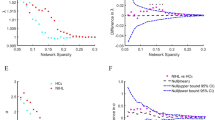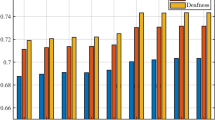Abstract
Auditory diseases such as deafness and tinnitus have been plaguing people for a long time. On the one hand, although cochlear implantation may serve as a cure for deafness to some degree, the mechanism of developmental neuroplasticity in the auditory and visual systems has not been well understood. On the other hand, there is still no cure for tinnitus, and investigating the cause and then developing the cure of tinnitus is particularly necessary. EEG signals provide us insights into these auditory diseases and have been widely studied for developing the cure of auditory diseases, in particular from the brain network perspective. However, most of the existing methods either simply utilize lower-order features of the brain network at the level of local connections within selected brain regions or fail to analyze the EEG signals from the brain region connectivity perspective. In this paper, based on the EEG signals, we develop a new higher-order brain network analysis method termed HBNmining (higher-order brain network mining) based on the weighted motifs and colored motifs for deepening the understanding of the auditory diseases. In particular, after constructing brain network from EEG signals, both the weighted motifs and the colored motifs are extracted, from which subject classification and brain region connectivity analysis can be conducted respectively. The results have confirmed the effectiveness of our method, which may be helpful for clinical treatment of auditory diseases.









Similar content being viewed by others
Explore related subjects
Discover the latest articles, news and stories from top researchers in related subjects.References
Adami C, Qian J, Rupp M, Hintze A (2011) Information content of colored motifs in complex networks. Artif Life 17(4):375–390
Ahirwal MK, Kumar A, Singh GK (2013) EEG/ERP adaptive noise canceller design with controlled search space (CSS) approach in cuckoo and other optimization algorithms. IEEE ACM Trans Comput Biol Bioinform 10(6):1491–1504
Alvarenga KF, Amorim RB, Agostinho-Pesse RS, Costa OA, Nascimento LT, Bevilacqua MC (2012) Speech perception and cortical auditory evoked potentials in cochlear implant users with auditory neuropathy spectrum disorders. Int J Pediatr Otorhinolaryngol 76(9):1332–1338
Benson AR, Gleich DF, Leskovec J (2016) Higher-order organization of complex networks. Science 353(6295):163–166
Braitenberg V, Schüz A (2013) Cortex: statistics and geometry of neuronal connectivity. Springer, Berlin
Cao B, Zhan L, Kong X, Philip SY, Vizueta N, Altshuler LL, Leow AD (2015) Identification of discriminative subgraph patterns in fMRI brain networks in bipolar affective disorder. In: International conference on brain informatics and health. Springer, pp 105–114
Chandaka S, Chatterjee A, Munshi S (2009) Cross-correlation aided support vector machine classifier for classification of EEG signals. Expert Syst Appl 36(2):1329–1336
Cheng CY, Huang CY, Sun CT (2008) Mining bridge and brick motifs from complex biological networks for functionally and statistically significant discovery. IEEE Trans Syst Man Cybernet Part B (Cybernet) 38(1):17–24
Choobdar S, Ribeiro P, Silva F (2012) Motif mining in weighted networks. In: 2012 IEEE 12th international conference on Data mining workshops (ICDMW). IEEE, pp 210–217
Das MK, Dai HK (2007) A survey of DNA motif finding algorithms. BMC Bioinform 8(7):S21
Davidson I, Gilpin S, Carmichael O, Walker P (2013) Network discovery via constrained tensor analysis of fMRI data. In: Proceedings of the 19th ACM SIGKDD international conference on knowledge discovery and data mining. ACM, pp 194–202
Hu B, Li X, Sun S, Ratcliffe M (2016) Attention recognition in EEG-based affective learning research using CFS + KNN algorithm. IEEE ACM Trans Comput Biol Bioinform 15:38
Huang S, Li J, Ye J, Fleisher A, Chen K, Wu T, Reiman E (2011a) Brain effective connectivity modeling for Alzheimer’s disease by sparse Gaussian Bayesian network. In: Proceedings of the 17th ACM SIGKDD international conference on knowledge discovery and data mining. ACM, pp 931–939
Huang S, Li J, Ye J, Wu T, Chen K, Fleisher A, Reiman E (2011b) Identifying Alzheimer’s disease-related brain regions from multi-modality neuroimaging data using sparse composite linear discrimination analysis. In: Advances in neural information processing systems, pp 1431–1439
Husain FT, Schmidt SA (2014) Using resting state functional connectivity to unravel networks of tinnitus. Hear Res 307:153–162
Kashani ZRM, Ahrabian H, Elahi E, Nowzari-Dalini A, Ansari ES, Asadi S, Mohammadi S, Schreiber F, Masoudi-Nejad A (2009) Kavosh: a new algorithm for finding network motifs. BMC Bioinform 10(1):318
Li PZ, Li JH, Wang CD (2016) A SVM-based EEG signal analysis: an auxiliary therapy for tinnitus. In: Proceedings of the advances in brain inspired cognitive systems. In: 8th international conference, BICS 2016, Beijing, China, November 28–30 2016. Springer, vol 8, pp 207–219
Liu J, Liang M, Chen Y, Wang Y, Cai Y, Chen S, Chen L, Li X, Qiu Z, Jiang J et al (2017) Visual cortex activation decrement following cochlear implantation in prelingual deafened children. Int J Pediatr Otorhinolaryngol 99:85–89
Mangan S, Alon U (2003) Structure and function of the feed-forward loop network motif. Proc Nat Acad Sci 100(21):11,980–11,985
Milo R, Shen-Orr S, Itzkovitz S, Kashtan N, Chklovskii D, Alon U (2002) Network motifs: simple building blocks of complex networks. Science 298(5594):824–827
Prat-Perez A, Dominguez-Sal D, Brunat JM, Larriba-Pey JL (2016) Put three and three together: triangle-driven community detection. ACM Trans Knowl Discov Data 10(3):22
Ribeiro P, Silva F (2012) Querying subgraph sets with g-tries. In: Proceedings of the 2nd ACM SIGMOD workshop on databases and social networks. ACM, pp 25–30
Ribeiro P, Silva F (2014a) Discovering colored network motifs. In: Complex networks V. Springer, pp 107–118
Ribeiro P, Silva F (2014b) G-tries: a data structure for storing and finding subgraphs. Data Min Knowl Discov 28(2):337–377
Sharma A, Campbell J, Cardon G (2015) Developmental and cross-modal plasticity in deafness: evidence from the P1 and N1 event related potentials in cochlear implanted children. Int J Psychophysiol 95(2):135–144
Shen-Orr SS, Milo R, Mangan S, Alon U (2002) Network motifs in the transcriptional regulation network of Escherichia coli. Nat Genet 31(1):64
Sporns O, Kötter R (2004) Motifs in brain networks. PLoS Biol 2(11):e369
Subasi A, Gursoy MI (2010) EEG signal classification using PCA, ICA, LDA and support vector machines. Expert Syst Appl 37(12):8659–8666
Vanneste S, De Ridder D (2015) Stress-related functional connectivity changes between auditory cortex and cingulate in tinnitus. Brain Connect 5(6):371–383
Vanneste S, Plazier M, Van Der Loo E, Van de Heyning P, Congedo M, De Ridder D (2010) The neural correlates of tinnitus-related distress. NeuroImage 52(2):470–480
Wang SJ, Cai YX, Sun ZR, Wang CD, Zheng YQ (2017) Tinnitus EEG classification based on multi-frequency bands. In: Proceedings of the 24th international conference on neural information processing, pp 788–797
Wernicke S (2006) Efficient detection of network motifs. IEEE ACM Trans Comput Biol Bioinform 3(4):347–359
Ye J, Chen K, Wu T, Li J, Zhao Z, Patel R, Bae M, Janardan R, Liu H, Alexander G, et al (2008) Heterogeneous data fusion for Alzheimer’s disease study. In: Proceedings of the 14th ACM SIGKDD international conference on Knowledge discovery and data mining. ACM, pp 1025–1033
Yeo BT, Krienen FM, Sepulcre J, Sabuncu MR, Lashkari D, Hollinshead M, Roffman JL, Smoller JW, Zöllei L, Polimeni JR et al (2011) The organization of the human cerebral cortex estimated by intrinsic functional connectivity. J Neurophysiol 106(3):1125–1165
Zalesky A, Fornito A, Bullmore ET (2010) Network-based statistic: identifying differences in brain networks. NeuroImage 53(4):1197–1207
Zhang XD, Song J, Bork P, Zhao XM (2016) The exploration of network motifs as potential drug targets from post-translational regulatory networks. Sci Rep 6(20):558
Acknowledgements
This work was supported by NSFC (61502543, 81600808), Guangdong Natural Science Funds for Distinguished Young Scholar (2016A030306014), Tiptop Scientific and Technical Innovative Youth Talents of Guangdong special support program (2016TQ03X542) and Shenzhen Innovation Program (JCYJ20150401145529008).
Author information
Authors and Affiliations
Corresponding author
Rights and permissions
About this article
Cite this article
Li, PZ., Cai, YX., Wang, CD. et al. Higher-Order Brain Network Analysis for Auditory Disease. Neural Process Lett 49, 879–897 (2019). https://doi.org/10.1007/s11063-018-9815-7
Published:
Issue Date:
DOI: https://doi.org/10.1007/s11063-018-9815-7




